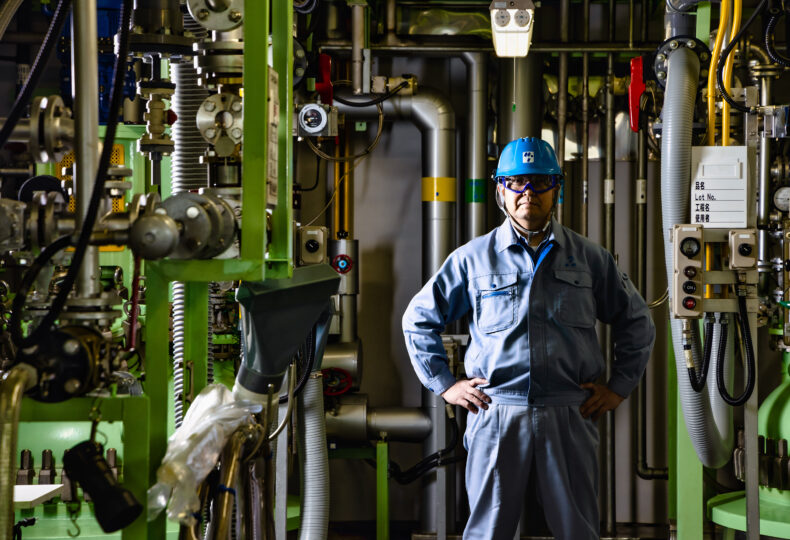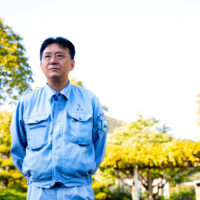
“It’s useless…” Succeeding in bringing a gynecological investigational drug intermediate to manufacturing after a never-ending wait! From the factory floors of intermediates for new drugs (Part 1)
Manac researches, develops, and manufactures chemical intermediates and active pharmaceutical ingredients used in pharmaceutical products. Supervising manager of manufacturing Mitsuhiro Hirono has primarily been involved with the manufacture of active pharmaceutical ingredients and intermediates for investigational drugs during the 14 years since joining Manac. With human life at stake, these materials must clear strict laws and regulations. Mr. Hirono gave us behind-the-scenes details about this process.
■ What you can learn from this article ✔ Manac manufactures APIs and intermediates for pharmaceuticals while observing strict regulations. ✔ A drug intermediate developed over more than 10 years has reached the application stage. ✔ Drug development involves many challenges; although success is rare, the knowledge gained aids future development. ■ Recommended Articles ・ Tight clean room management:“I want to oversee a new active pharmaceutical ingredient from formulation through to manufacturing” – From the factory floors of intermediates for new drugs (Part 2) ・ Responsibility and accomplishment as the engine of work / the younger members of the pharmaceutical manufacturing team (1) ・ Second year at MANAC and “put in charge, from raw material preparation through to final product” / the younger members of the pharmaceutical manufacturing team (2) ・ MANAC’s three strengths in manufacturing active pharmaceutical ingredients and intermediates
contents
Observing ever-stringent laws and regulations
Before joining Manac, Mr. Hirono belonged to a pharmaceutical company, where he was involved in the development and manufacture of active pharmaceutical ingredients (APIs) and investigational drugs. His experience led him to join Manac 14 years ago.
Currently, Mr. Hirono belongs to Manac’s manufacturing division as a supervising manager of manufacturing for pharmaceuticals, and mainly oversees APIs and pharmaceutical intermediates for use as active ingredients in prescription pharmaceuticals.
“Since drugs are taken by people suffering from an illness, drugs have always been subject to complex regulations. But standards for these regulations are growing more stringent every year. It’s quite challenging to manufacture products while working to keep up with these changes in regulations.”
Mr. Hirono explains that there are many occasions where they would like to make manufacturing processes slightly less costly or more simplified, but end up running into barriers from regulations, and have no choice but to abandon such goals.
“I believe finding ways to get around this kind of issue will be an important topic in the industry.”
Finally progressing to application submission after more than ten years of development
One of the products that Manac is currently focusing on the most is a drug intermediate for a new gynecological investigational drug. Manac manufactures some of the intermediates used in this new drug, while other companies manufacture the rest. Mr. Hirono explains that these are then combined to produce a single drug. Since each company has its areas of specialty and areas that fall outside such areas of strength, there are many examples of multiple companies manufacturing different components to finally produce a single drug.
The development of drugs requires an overwhelming amount of time. It took more than ten years for this new drug intermediate since Manac started consideration of its manufacture. After dedicating many daunting years, the new drug has finally advanced to the application submission phase.
Mr. Hirono has been involved in this new drug since joining Manac. He set his sights on the potential for authorization to be obtained and the new drug to be created in the near future if the process progressed smoothly.

Carrying out a series of clinical trials in phases
The development of a new drug starts with preclinical studies, which administer the drug to small animals such as mice and monitors reactions to the drug’s presence in the blood. New drugs then advance on to clinical trials, which are carried out in three phases. Clinical trials start with healthy participants and then move on to a small number of patients before finishing with a large number of patients. While the trials check for the effectiveness of new drugs, they also confirm whether there are any negative effects on human health during a period of ten years.
“There is an astounding number of drugs that have been terminated during the animal testing phase due to a lack of effectiveness or the occurrence of adverse effects.”
There are many reasons behind such results, ranging from the drug losing its efficacy once absorbed to the drug becoming toxic due to reactions in the body. Even though the gynecological investigational drug being developed this time progressed relatively smoothly through clinical trials, it still required more than ten years.
“It’s useless” – Nearly giving up
“We struggled throughout the first manufacturing stages for the intermediate of this new drug. Changing the order of the various raw materials would change the amount of resulting impurities and the targeted product. Small variations in the temperature or time would also impact product quality, and so finding ways to stabilize the process was challenging.”
The production of new drugs is tested in the lab during the research phase, and is then brought to the factory floor for manufacturing once production is confirmed to be safe. However, there are many cases in which reactions that did not occur during the research phase occur with a larger amount of the materials. When this happens, a list of issues is given back to the lab as feedback. The lab then makes changes to the process and sends it back to the factory, further repeating this process as necessary.
“There were times I thought that it was useless to keep trying since there are certain things that are just beyond our capability.”
Since trial results are confidential, there are periods during which Manac receives little information. Mr. Hirono explains that there was a time when such a period lasted for three years, and he thought the drug must not have passed.
“These trials determine whether the last ten years were all for nothing, or if they will pay off. All you can do is pray while you wait. This, of course, invites worry, but in the world of drug development, it is natural for trial drugs to fall through. You’re truly lucky if a new drug succeeds. The overwhelming majority of the new drugs I myself have worked on didn’t make the cut.”
Mr. Hirono further explained that even for new drugs that do not yield positive results, it is not a waste as there is a lot of knowledge gained throughout the process. Using such knowledge toward the next product development makes the process beneficial for the company, and can help advance the company to the next stage. This knowledge becomes an asset in the expertise that Manac continues to build.
*In part two of this story, we learn about how difficulties in the manufacturing process are overcome.













